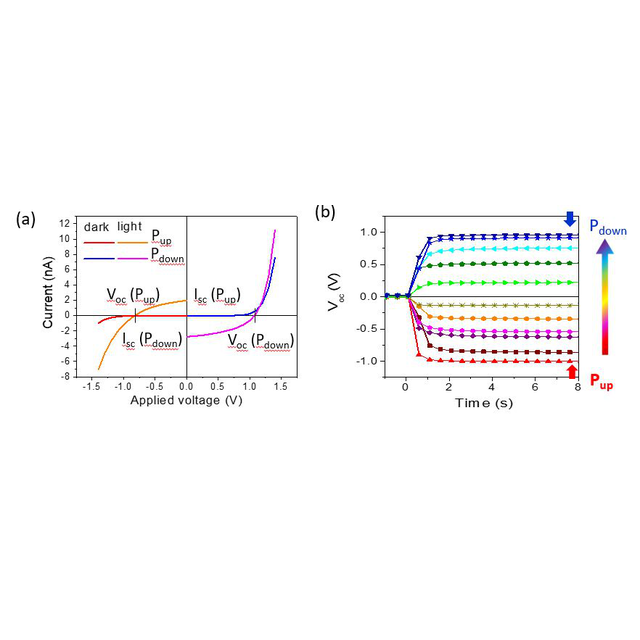Researchers from C2N have developed a nonvolatile oxide memory device based on ferroelectric thin films showing eight stable and well-controlled information states. The information, stored in the remanent ferroelectric polarization of the material, can be written electrically by voltage pulse and read optically through polarization-dependent short-circuit photocurrent or open circuit photovoltage. These results are particularly exciting for the development of next-generation ferroelectric memory devices with increased memory storage density and lower power consumption.
Intensive research into functional oxides has been triggered by the quest for a solid-state universal memory with high-storage density, nonvolatility, high read/write speed, and random access. The ferroelectric random-access memory (FeRAM), in which the information is stored in the spontaneous ferroelectric polarization of the material, offers great promise as nonvolatile and multistate memory, but its destructive electrical reading step requires a rewrite step after each reading, increasing energy consumption. As an alternative, optical nondestructive readout can be achieved, based on the ferroelectric polarization dependence of the photovoltaic (PV) response in ferroelectric materials.
The interaction with light in ferroelectrics induces a particular polarization-related charge-separation mechanism, called the bulk photovoltaic effect. The direction of the ferroelectric polarization can control the sign of both short-circuit photocurrent (Isc) and open-circuit voltage (Voc), theoretically allowing for 100% switchability of the PV characteristics. In practice, this switchability is often limited in ferroelectric thin films integrated between electrodes due to asymmetric behaviors originating from interfacial PV effects and the presence of an unswitchable internal bias field. Up to now, the optical nondestructive readout of the polarization has thus been reported in ferroelectric memories with limited photocurrent switchability.
In this work, we report a symmetric capacitor structure demonstrating a clear proportionality between Isc (Voc) and the remanent polarization, allowing to achieve a 100 % switchability of the photovoltaic response. Thanks to this quantitative polarization dependence of Isc and Voc, both can be used as a non-destructive read-out signal of the polarization states in ferroelectric memory devices. Multiple polarization states have been created, whose number is only limited by the electrical writing step precision, thanks to the very high sensitivity of the optical reading method. Oxide memory devices based on 3-bit data storage have been assessed, showing very good performance in terms of data retention, fatigue behavior, and repeatability of writing and reading cycles. This reported non-destructive optical reading of multistate polarization based on the switchable polarization-dependent PV response in ferroelectrics offers great promise for next-generation ferroelectric memory devices with increased memory storage density and lower power consumption.
References
Optical reading of multistate nonvolatile oxide memories based on the switchable ferroelectric photovoltaic effect
Alexandre Zing1, Sylvia Matzen1, Komalika Rani1, Thomas Maroutian1, Guillaume Agnus1, Philippe Lecoeur1
Applied Physics Letters 121, 232904 (2022)
https://doi.org/10.1063/5.0123328
Affiliations
1Centre for Nanoscience and Nanotechnology - C2N (CNRS, Paris-Saclay University)
Contacts C2N
Alexandre Zing / Sylvia Matzen
Keywords
oxides thin films, ferroelectric materials, memories, photovoltaic









